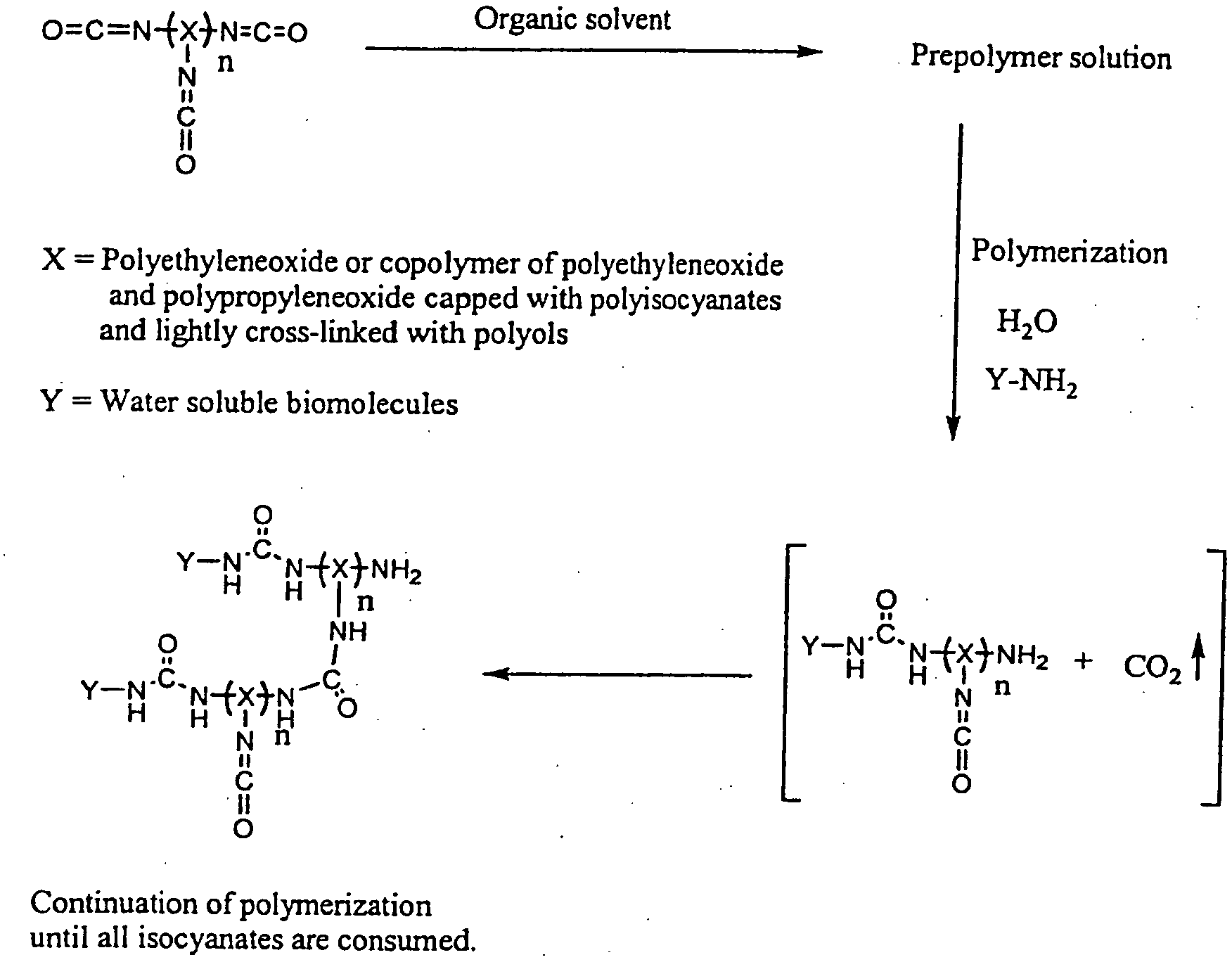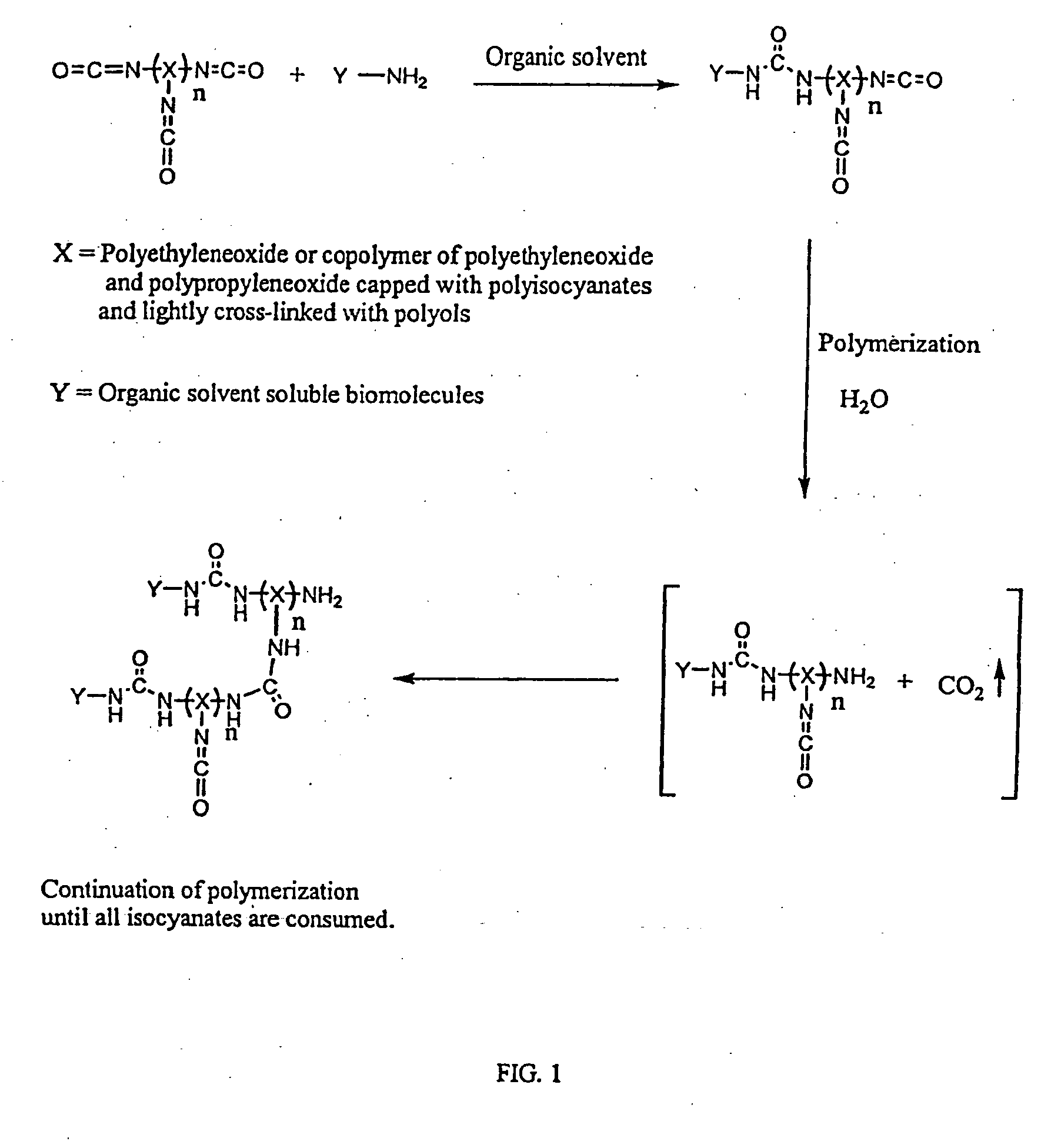3D format biochips and method of use
a biochip and 3d technology, applied in the field of 3d format biochips and methods of use, can solve the problems of difficult fabrication, easy disruption, and restrictive attachment chemistries, and achieve the effects of improving assay accuracy, simple method, and improving sensitivity
- Summary
- Abstract
- Description
- Claims
- Application Information
AI Technical Summary
Benefits of technology
Problems solved by technology
Method used
Image
Examples
example 1
Preparation of a DNA Biochip and Test
[0072] A solution of 0.025 g of Hypol PreMa G-50 was prepared in 0.15 g acetonitrile. Next, a solution of 1 mg DNA (0.3 μm), having hexaneamine at its 5′ end and having the sequence NH2(CH2)6-CATTGCTCAAAC-3′ (SEQ ID NO: 1), in 0.32 g of a 50 mM NaHCO3 aqueous buffer at pH 8.0 was prepared. The DNA solution was added to the prepolymer solution and thoroughly mixed. Droplets of the resulting solution were manually spotted on an amino silanated glass slide using a capillary microtube. As a negative control, some hydrogel droplets containing no DNA were spotted next to the DNA-containing hydrogel droplets.
[0073] The glass slide, having microspots thereon formed from the hydrogel droplets, was submersed into washing buffer (10 mM sodium phosphate buffer with 0.5 M NaCl and 0.1% SDS at pH 7.0) for 30 minutes to remove organic solvents and block the remaining active sites to prevent non-specific binding of test DNA. Next, the slide was treated with 1 ...
example 1a
Preparation of an Array DNA Biochip and Test in Human β-globin Gene Sequence Detection
[0074] A DNA biochip was prepared as follows: [0075] 1. The following two reactant solutions were prepared: [0076] Solution A=0.1 g Hypol Pre-Ma G-50 in 0.33 g acetonitrile and 0.33 g NMP (Weight ratio of 4.5:15:15) [0077] Solution B=1 mg of oligonucleotide in 1 ml of 50 mM borate buffer at pH 8.0 [0078] 2. Solution A (34.5 parts) was mixed with Solution B (65.5 parts), and the resultant solution microspotted onto a glass slide. Microspotting was performed with an open configuration pin, CT MicroPipets DP-120 μm, supplied by Conception Technologies. [0079] 3. The microspotted slides were placed into a controlled humidifier chamber for one hour and then washed with a washing buffer for 10 minutes, completing the preparation of the biochips.
[0080] Testing of such a biochip is performed by hybridization with a target sample carrying a fluorescent tag or the like at different concentrations in a hybr...
example 2
Use of Additives (glycerol / trehalose) to Enhance Bioactivity
[0085] The following example shows that unreactive proteins, simple carbohydrates and humectants have a protective effect on hydrogel-immobilized antibody activities of these biochips, enhancing overall signal and assay performance.
[0086] Panel A—Trehalose. In this experiment, aliquotes of a trehalose stock solution, 50% w / v D(+) trehalose dihydrate in 50 mM sodium borate buffer, pH 8.0, were added to 50 μl final volume hydrogel formulation. The formulation also included 3.5 weight % final concentration HYPOL PreMA® G-50 hydrogel prepolymer (premixed stock solution containing HYPOL, acetonitrile, N-methyl-2-pyrrolidinone at a w / w / w ratio of 1:3:3, respectively), anti-transferrin (4 mg / ml phosphate buffered saline IX (PBS), 2 μl bovine IgG (50 / mg / ml in PBS and 1.25% glycerol). The amount of trehalose was varied from 0 to 10 μl, corresponding to a final w / v percentage of 0, 1%, 2%, 5% and 10% trehalose. A blank hydrogel spo...
PUM
| Property | Measurement | Unit |
|---|---|---|
| Length | aaaaa | aaaaa |
| Thickness | aaaaa | aaaaa |
| Thickness | aaaaa | aaaaa |
Abstract
Description
Claims
Application Information
 Login to View More
Login to View More - R&D
- Intellectual Property
- Life Sciences
- Materials
- Tech Scout
- Unparalleled Data Quality
- Higher Quality Content
- 60% Fewer Hallucinations
Browse by: Latest US Patents, China's latest patents, Technical Efficacy Thesaurus, Application Domain, Technology Topic, Popular Technical Reports.
© 2025 PatSnap. All rights reserved.Legal|Privacy policy|Modern Slavery Act Transparency Statement|Sitemap|About US| Contact US: help@patsnap.com



